Search results
27- Days to Change the Way We Eat
I once read that it takes 27 days to change a habit, either good or bad. 27-days to stop smoking, start a diet and stick to it, or make exercise part of your daily routine. In 27 days the “new” habit has formed in the brain and becomes second nature, you do it without thinking.
So why am I telling you all this?
Because today is Day One of a 27-day family challenge to eat more locally, buy locally and consume locally. It’s a personal challenge I know, but one I hope many of our readers will champion as well. If we stop and look (or research) what is available in our county I think we would all be surprised at how many of the ingredients needed to make a meal can be found in close proximity to where we live. I have to admit that even I sometimes forget what can be found just a few miles from my home.
The challenge will mean a lot of cooking at home, eating harvested animals, shopping in the pantry (or the garden), at farm stands and Farmer’s Markets, and much more. What it doesn’t mean though is giving up on condiments, spices, tea and staples I already have on hand like flour, sugar, olive oil, rice, beans and pasta. I’ll document our progress, and be honest about the pit falls: added work of making bread on a Tuesday after work, the challenge of gardening with a full-time job and a kid in school and the sabbatical my hens sometimes go on, leaving us with no eggs for days.
It will also mean a few sacrifices (swearing off Dr. Pepper and Mint Chip ice cream for starters, but that’s not necessarily a bad thing.). We’ll be eating within 60 miles of our home (the size of our county) and sometimes 60 feet from our own back door for the next 27 days; and not for the reasons you may be thinking of – supporting the local farm economy, increase in transportation costs of goods, factory farms, high intensity animal feedlots…that kind of thing. Nope, none of that.
We’re doing this for a lot of reasons, but mostly because we want to make a permanent change to the way we think about our food. We want to jumpstart our dedication to growing even more of our own food and buying what we don’t as locally as possible. I want to know how much effort it will take and how much cheaper (or expensive) it is to truly eat where we live. So, for the next several weeks I’ll be writing about all the gory details and shining triumphs, along with some of the recipes I used just to entice all of you to jump on board.
Here are a few of our ground rules:
- Shop at home first (freezer, larder, pantry, garden, barn).
- When needed, shop local farm stands and farmers markets.
- Buy, barter or trade for local meat we don’t raise ourselves.
- Bake from scratch (wheat is a CA crop, but not farmed locally. It comes from 100 miles away, but is milled into flour 50 miles away. Works for me).
- Source relatively local dairy products.
- Cold turkey on candy, chips, sodas, fast foods, etc. (although these are not big items at our home, just the idea of it may kill Brianne).
- Eat three square meals a day, plus snacks.
- Staples, condiments, oils, spices and seasonings already on hand are allowed.
- Drink at least ½ gallon of water a day.
- Walk at least 3 miles day.
Sound like a plan? Stay tuned to see how we faire.
Roasted Chicken with Lemony Potatoes
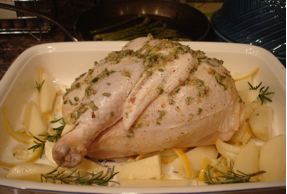 There’s nothing better than opening your freezer and pantry doors and being able to pull together not only a satisfying meal, but one where almost all the ingredients are grown within a few miles of your back door.
There’s nothing better than opening your freezer and pantry doors and being able to pull together not only a satisfying meal, but one where almost all the ingredients are grown within a few miles of your back door.
Last night, after a day of cleaning and de-cluttering; giving away, putting away or throwing away, I fixed one of our favorite chicken dishes — Roasted Chicken with Lemony Potatoes.
The half chicken, weighing over three pounds, once clucked and scratched and wandered around our small farm. The lemons hang abundantly on my neighbor’s tree, and they are delighted to share with everyone on our street. The rosemary and garlic grows feet from the house. Only the potatoes, olive oil, red pepper flakes and salt came from parts unknown or far away.
Best Ever Berry Jam
Within 5 miles of our house we have three U-pick operations and several Farmer’s Markets where we can find a good selection of seasonal berries. And, although there is nothing better than jumping in the car, combing fields for the freshest produce and ripping it from the soil, the place I like the best is my neighbor’s backyard.
We watch Fran and Joe’s place, feed the chickens and water the gardens when they are on vacation. Our payment…anything that’s ripe.
It was cloudy and a slight westerly breeze blew when Brianne and I walked down the street to check on things. As Brianne went about her chores, I headed for the berry patch. The huge, dark blackberries clung to their canes like gems. I filled my colander. I had a plan. That afternoon I would take these little gems and cook them slowly on the stove, filling the house with their sweet aroma. Mmmm.
Making any kind of Berry Jam is easy. All you really need is berries and sugar. You can use pectin (liquid or powder) if you like, but I prefer not to. I just fill a large pot with 9 cups of berries and 6 cups of sugar, turn the heat on and slowly bring to a boil, stirring occasionally, until all the sugar is dissolved. At this point I either mash the berries with a potato masher or lightly whirl them with an emersion blender, making sure to leave a bit of chunkiness. I continue cooking and stirring the jam rapidly until it reaches the gelling point. When the jam is gelled enough I remove it from the stove and ladle it into hot jars. The jars are dropped into the water bath canner for 15 minutes then set on a clean dry cloth to cool. When you hear the tell-tale POP of the lid, signaling the proper seal, you know you’ve done it right.
The whole process, from first wash of berries to the last lid POPPING takes less than an hour. And, for that you get enough berry goodness to remind you of summer all winter long. I made 9 pints of jam. That’s a lot of jam, folks! And, what a bargain, too. For the price of a few jars and lids, and free berries from friendly neighbors my pantry is stocked with something way better than Smuckers. Not a bad deal!
For detailed instructions, pick up a copy of the famous Ball Blue Book Guide to Preserving, at any hardware, farm store, book or discount store. It covers everything you need to know about canning and costs less than a case of jars. Enjoy!
![]() photo credit: Price Finder
photo credit: Price Finder
A Life Lived in Grace

This beginning of a New Year is like a bend in a winding mountain road. It fades in my rearview as we move farther and farther from its starting point. I’ve been reflecting lately on all that can be accomplished on a small suburban homestead such as ours and feeling rather – well – contented and secure.
On just a third of an acre we are able to raise lambs and chickens to put meat in our freezer and eggs for breakfast and baking. An extra lamb we butchered is being parceled out to friends and neighbors who don’t want a whole or half lamb. And, at $9 to $15 per pound for organic lamb, I think this may turn out to be a very good thing.
The broilers we raised from day old chicks were butchered last week. Our original plan was to butcher before Christmas, but the bad weather and family obligations forced us to push back a few weeks. With the extra time on feed most of the birds were in the 7 to 8 pound range, with a few pushing over 9 pounds. At those weights the birds are too big for a family of two, so most were cut in half and a few quartered, giving us enough chicken for about 30 weeks, assuming we eat chicken once a week. Not bad, folks! Not bad at all!
The hens are laying 5 to 7 eggs a day now, not quite at full stride yet, but, that’s 3-1/2 dozen a week, enough to keep us in omelets with a few dozen left over to sell to cover feed costs.
Our berries and fruit trees are coming into their own and give us plenty of fresh seasonal fruit for eating and a little extra for freezing or canning or cooking; the garden gives us plenty of greens and root vegetables; tomatoes and cucumbers; squash and pumpkins, even with the occasional crop failure.
Thanks to some great sales in November and December our pantry is brimming with staple goods. And, the added savings from coupons meant most were “free” or nearly “free”. It’s so nice to be able to just walk over, open a cupboard and pull out what you need for an evening meal. No treks to the store after dark. No drives during inclement weather.
We picked up another load of firewood from the grandparents’ place, our second of the winter. With the colder temperatures we are burning more wood than in years past and it’s a blessing to have such a ready source. Loading split wood on a cool afternoon makes for a robust workout. I love it.
I think these reflections were brought on by a morning news story on the inflationary period coming our way.
Mix It Up
Making Your Own Mixes Can Save You Big



For years I purchased packaged mixes. You know the ones – chili, salad dressing, marinades and drinks. They may be quick and easy to use, but who needs all those chemicals so often used in processed foods coursing through your veins much less the increased cost of buying in small qualities. In just a few minutes on a slow evening you can create all of your family’s favorite mixes. Most ingredients will be in your stocked pantry and the ones you need to buy will cost a fraction per serving over the mixes you’re already buying.
Take for instance, Pumpkin Pie Spice. A container that weighs less than an ounce can cost between $3 and $4. But, if you have a well stocked pantry you probably already have all the ingredients you need to make your own – minus the preservatives that are added to commercially made mixes.
So take a few minutes and whip up your family’s favorites or most often used mixes. When stored in air tight containers they will last for months. Recycled pint-sized jars make the perfect container for most mixes, and have room for labels and recipes so they can be refilled later.
Souper Sunday Afternoon
The predicted storm did not materialize over the weekend, but the weather was still cold enough to enjoy a roaring fire all day long. It was a lazy Sunday afternoon with the wind billowing outside and grey clouds hanging low enough you felt like you could reach up a grab them. It was one of those days when you spent more time inside than out.
Weather like this cries out for food that’s warm and soothing. It calls out for a steaming, bubbling pot of soup; the kind that fills the house with aroma of herbs and spices; vegetables and meat.
When Brianne was younger I would send her to school with a thermos of piping hot soup almost every day of winter. It became the running joke in our house that “mom could make soup out of anything” and it wasn’t far off. Give me a leftover chicken carcass or a doggie bag of beef from a recent restaurant trip, along with a few veggies from the fridge and a small amount of pasta, rice or barley from the pantry and I could whip it into a steaming, hearty pot of soup, perfect for two.
We still eat a lot of soup during the winter months, transformed from a variety of leftovers or created from ingredients in our pantry. But, our creations are a bit more elaborate as our tastes have changed and our desires for more exotic creations have grown.
So, if old man winter gives you the cold shoulder fend him off with a simmering pot of soup. Paired with a salad and a warm loaf of homemade bread smothered in butter, you have the perfect cold day meal. Tonight’s soup…
Pasta Fagioli
2 pounds – ground beef
1 each – onion, chopped fine
3 each – carrots, chopped fine
4 each – stalks celery, chopped fine
28 oz – diced tomatoes, undrained (canned or homemade)
16 oz – red kidney beans, drained (if using dried, soak overnight)
16 oz – white kidney beans, drained (if using dried, soak overnight)
30 oz – beef broth (canned or homemade)
3 tsp – oregano
2 tsp – pepper
5 tsp – parsley
20 oz – spaghetti sauce (canned or homemade)
8 oz – small shell pasta
Brown beef in skillet; drain fat and add to crock pot. Add all remaining ingredients, except past to crock pot and cook on high for 5 to 6 hours. During last 30 minutes add pasta. Makes 12 servings. Top each bowl with parmesan cheese if desired.
Serve with warm focaccia bread and salad.
This is a great recipe for using up that chicken carcass.
It’s amazing how much meat is left on a carcass when it’s cooked down. Before starting, put carcass in large pot and cover with water. Bring to a boil and turn heat down to simmer for about an hour. Remove carcass and place on a cutting board to cool. Reserve 4 cups of broth, remaining can be ladled into freezer containers for later use. When carcass has cooled, pull off as much meat as you can. The recipe below is based on 2 cups of meat.
Greek Lemon Chicken Orzo Soup

4 cups – chicken stock, or 14 ounces of canned broth
2 cups – chicken, chopped into bite-sized pieces
3/4 cup – orzo pasta
2 eggs
Juice from 1 large lemon (or to your personal preference)
Coarse salt and ground pepper to taste
Italian parsley
In a stock pot, combine 1 cup of water and broth, bring to a rapid simmer, add orzo and cook according to package directions. Add chicken to pot. In medium bowl, whisk together eggs and lemon juice. Whisking constantly, slowly pour 1 cup hot broth into egg mixture, immediately whisk egg mixture into stock pot. Season soup with salt and pepper, garnish with parsley. Makes 2 large servings.
Serve with warm pita and hummus, and a salad of lettuce, red onion, tomato, Kalamata olives and Feta cheese with Greek dressing.
![]() photo credit: jessicafm and recipegirl
photo credit: jessicafm and recipegirl
![]() photo credit: randomcuriosity
photo credit: randomcuriosity
Seasonal Sales Calendar
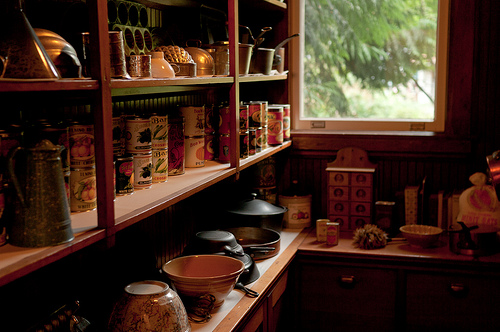
With the year coming to a close it’s a great time to lay the groundwork for stocking your pantry and home with needed items. An effective way to shop for food storage and other household items is to know when they typically go on sale.
Some of this is common sense. Seasonal items like winter coats generally go on sale by the end of December while gardening supplies can be purchased for less in the fall. But, some great information can be found on the Consumer Reports website, websites on stocking up and store ads. The Calendar below is just a sample of the items you can stock up throughout the year, helping to build a well supplied pantry and save money on other purchases. Be patient. Watch store ads for items that are 50% off or more. Shop when items are on sale. As time goes by and your pantry grows you’ll be spending less time in the market and more time shopping from your own pantry!
(Keep in mind that this is just a generalized list. Every part of the country is different and sale times and items may vary)
A Thrifty Thanksgiving
It’s November 2010, the elections are fresh in our minds and everywhere we go there are the reminders of the coming holiday season. But, the economy still looms heavy on our minds. Fears about jobs, price increases and shortages have us feeling uncertain about what this season will be like.
BUT – here on our little homestead we’re determined not to let this air of uncertainty affect our love of fall and one of the two biggest holidays of the calendar Thanksgiving. We have however decided to make this a budgeted holiday with plenty of memory making activities like free concerts, walks through the decorated areas of town with a mug full of warm apple cider and holiday programs.
So, how does one have a thrifty Thanksgiving dinner? By using what you have on hand, that’s how.
We’ll start a few days before Thanksgiving by thawing out a 9-1/2 pound roasting chicken from a batch we raised last year. I’ll make a few fresh loaves of bread (saving enough dough to make dinner rolls) with herbs from the garden baked in, as a base for our stuffing. When it’s cooled enough I’ll cube it and let it dry out.
On Wednesday I’ll prepare a brine of coarse salt, spices, herbs, apples and cider. The chicken will soak in the brining bucket, submerged in its flavorful concoction for 24-hours.
On Thanksgiving morning, once the animals are fed and morning chores complete, and the chicken is thoroughly rinsed and set out to come to room temperature, we’ll pack up our gear and head to our favorite hiking area. While most people are frantically trying to get their turkeys in the oven by mid-morning we’ll be trekking the hills breathing in fresh air and reveling in the colors of nature. Home by noon and with a light lunch of soup and grilled cheese sandwiches, on home baked bread, we’ll be fortified enough to put our energies into our evening meal.
Brianne will peel and cube homegrown potatoes for our cheesy herb infused mash, while my sister slices a newly harvested Butternut squash that will be baked with brown sugar, butter and spices. Greens will be washed and prepared for a wonderful fall mixed green, pecan, blue cheese and cranberry salad with Blueberry-Pomegranate dressing, all from ingredients in my pantry.
The stuffing, squash and dinner rolls will go into the oven and cook along with the bird.
Once the turkey – I mean chicken – is finished roasting I’ll whip up some gravy from the drippings and all will be laid out on a festive table as a grand feast.
The whole meal will be finished off with individual Harvest Pumpkin cakes, made from our own successful pumpkin patch, and topped with a cream cheese frosting and pecan halves.
There you have it, a wonderfully filling homegrown, homemade Thanksgiving feast.
For the rest of the evening we’ll settle into a roaring fire watching some of our favorite movies. I’ll take comfort in the fact that this years celebration was made mainly from ingredients we grew ourselves or already had one hand, with only a few items purchased at the Farmer’s Market for just a few dollars. I can now rest easy that what had caused me concern will turn out to be a wonderful and intimate celebration of the harvest.
That’s the perfect ending to a perfect day.
![]() photo credit: Alanna Kellogg
photo credit: Alanna Kellogg

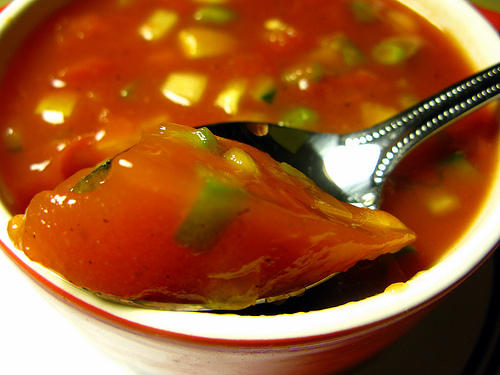
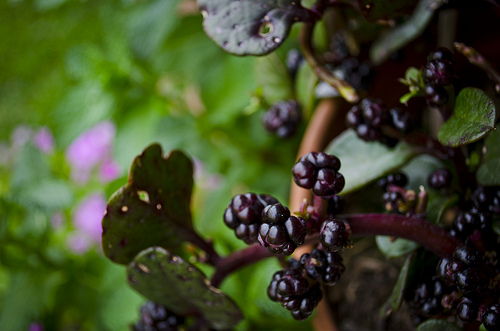


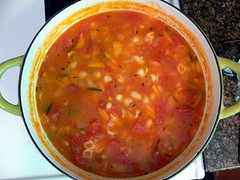

Recent comments
Aenean nonummy hendrerit mauris. Phasellus porta.